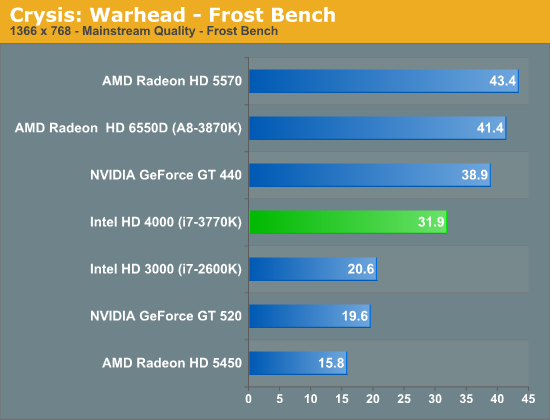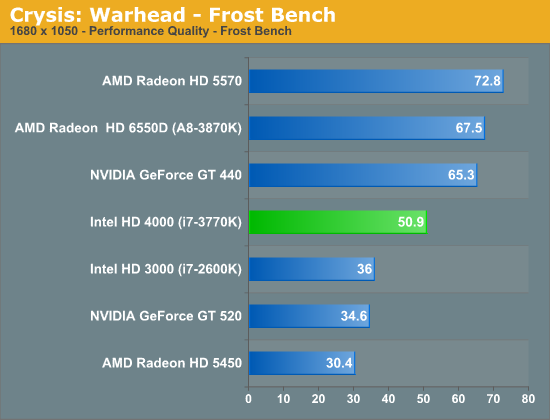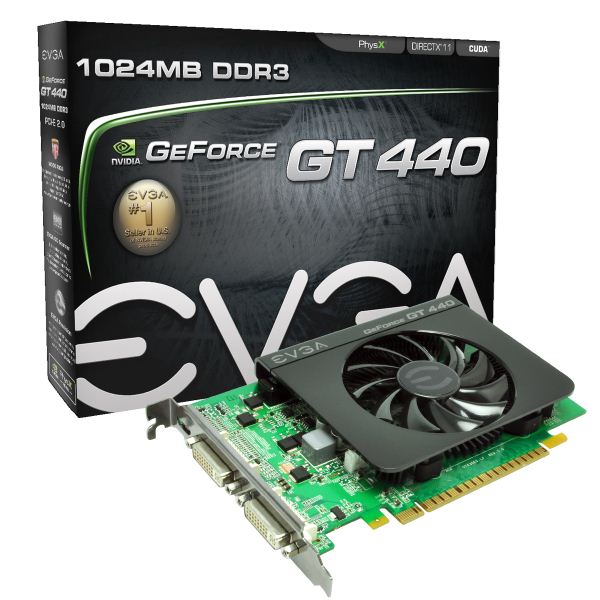The Ivy Bridge Preview: Core i7 3770K Tested
by Anand Lal Shimpi on March 6, 2012 8:16 PM EST- Posted in
- CPUs
- Intel
- Core i7
- Ivy Bridge
Intel HD Graphics 4000 Performance
With respectable but still very tick-like performance gains on the CPU, our focus now turns to Ivy Bridge's GPU. Drivers play a significant role in performance here and we're still several weeks away from launch so these numbers may improve. We used the latest available drivers as of today for all other GPUs.
A huge thanks goes out to EVGA for providing us with a GeForce GT 440 and GeForce GT 520 for use in this preview.
Crysis: Warhead
We'll start with Crysis, a title that no one would have considered running on integrated graphics a few years ago. Sandy Bridge brought playable performance at low quality settings (Performance defaults) last year, but how much better does Ivy do this year?

In our highest quality benchmark (Mainstream) settings, Intel's HD Graphics 4000 is 55% faster than the 3000 series graphics in Sandy Bridge. While still tangibly slower than AMD's Llano (Radeon HD 6550D), Ivy Bridge is a significant step forward. Drop the quality down a bit and playability improves significantly:


Over 50 fps at 1680 x 1050 from Intel integrated graphics is pretty impressive. Here we're showing a 41% increase in performance compared to Sandy Bridge, with Llano maintaining a 33% advantage over Ivy. I would've liked to have seen an outright doubling of performance, but this is a big enough step forward to be noticeable on systems with no discrete GPU.











195 Comments
View All Comments
sabot00 - Tuesday, March 6, 2012 - link
How long will Intel keep its HD Graphics increases?MonkeyPaw - Tuesday, March 6, 2012 - link
I don't understand the logic of selling a high end CPU with the best IGP. Seems like anyone running an it isn't going to stick with the IGP for games, and if they aren't gaming, then what good is that high-end GPU? Maybe the entire "Core i" line should use the HD 4000.Flunk - Tuesday, March 6, 2012 - link
Because the low end chips are just die-harvested high end chips it makes sense. No reason to disable it so they leave it on.And some people do actually use high end processors with IGPs. It's fairly easy to get one from a major OEM. It's stupid but most people don't know any better.
aahkam - Tuesday, March 27, 2012 - link
Funny comments I saw.What's wrong even if the High End CPU that comes with IGP?
Is High End CPU = Gaming Machine CPU? If that is your logic, you're a rich but shallow boy!
I do lots of Video Editing and Transcoding, I need High End CPU but None of the High End GPU beats Quick Sync in Transcoding in terms of Quality and Speed.
dqniel - Friday, April 6, 2012 - link
"and if they aren't gaming, then what good is that high-end GPU?"I feel like you missed that part. He's not saying that only gamers use high-end CPUs. He's saying that gamers using a high-end CPU won't care about the high-end iGPU because they won't use it. Also, non-gamers who need a high-end CPU generally won't see the benefits of the included high-end iGPU. So, he proposes that the better niche for the high-end iGPU would be on the more affordable CPUs, because then budget-minded gamers could buy an affordable CPU that has a relatively powerful iGPU integrated into it.
defter - Wednesday, March 7, 2012 - link
This is a mid-range CPU, not high-end one.High desktop CPUs (i7 3800-3900) don't have IGP.
KoolAidMan1 - Wednesday, March 7, 2012 - link
It is because laptops continue to get slimmer and slimmer. Getting good GPU performance without the compromises on the chassis that a dedicated GPU would force is the point.Tormeh - Wednesday, March 7, 2012 - link
This.My next laptop will have processor graphics for the sake of battery life and size, and whoever has the best graphics gets my money.
bznotins - Wednesday, March 7, 2012 - link
Seconded.aguilpa1 - Wednesday, March 7, 2012 - link
If the 4000HD is on the level of lets say a 560m I would not hesitate to get a laptop with no dedicated graphics but if it isn't I'm still going to go for the dedicated.